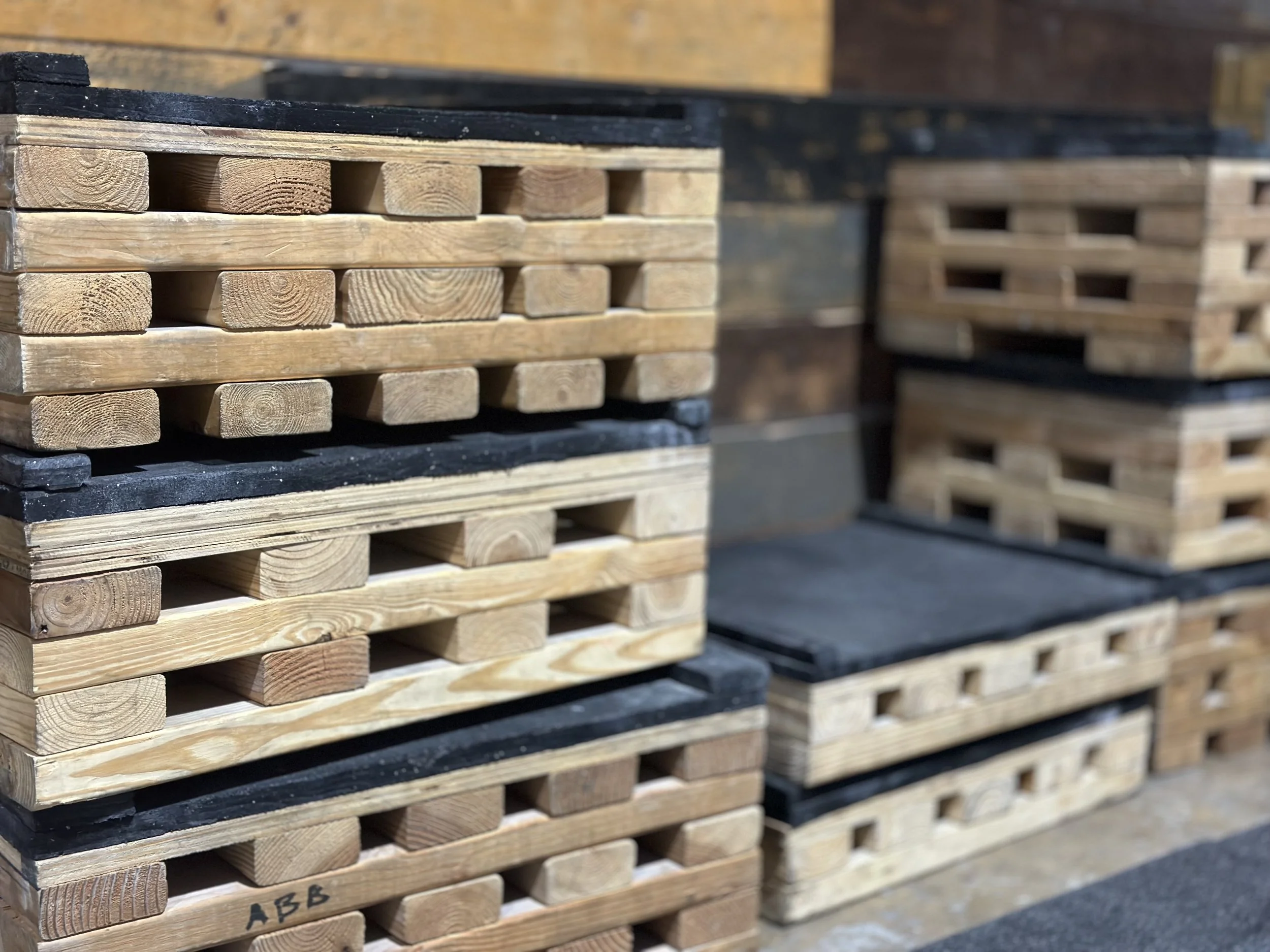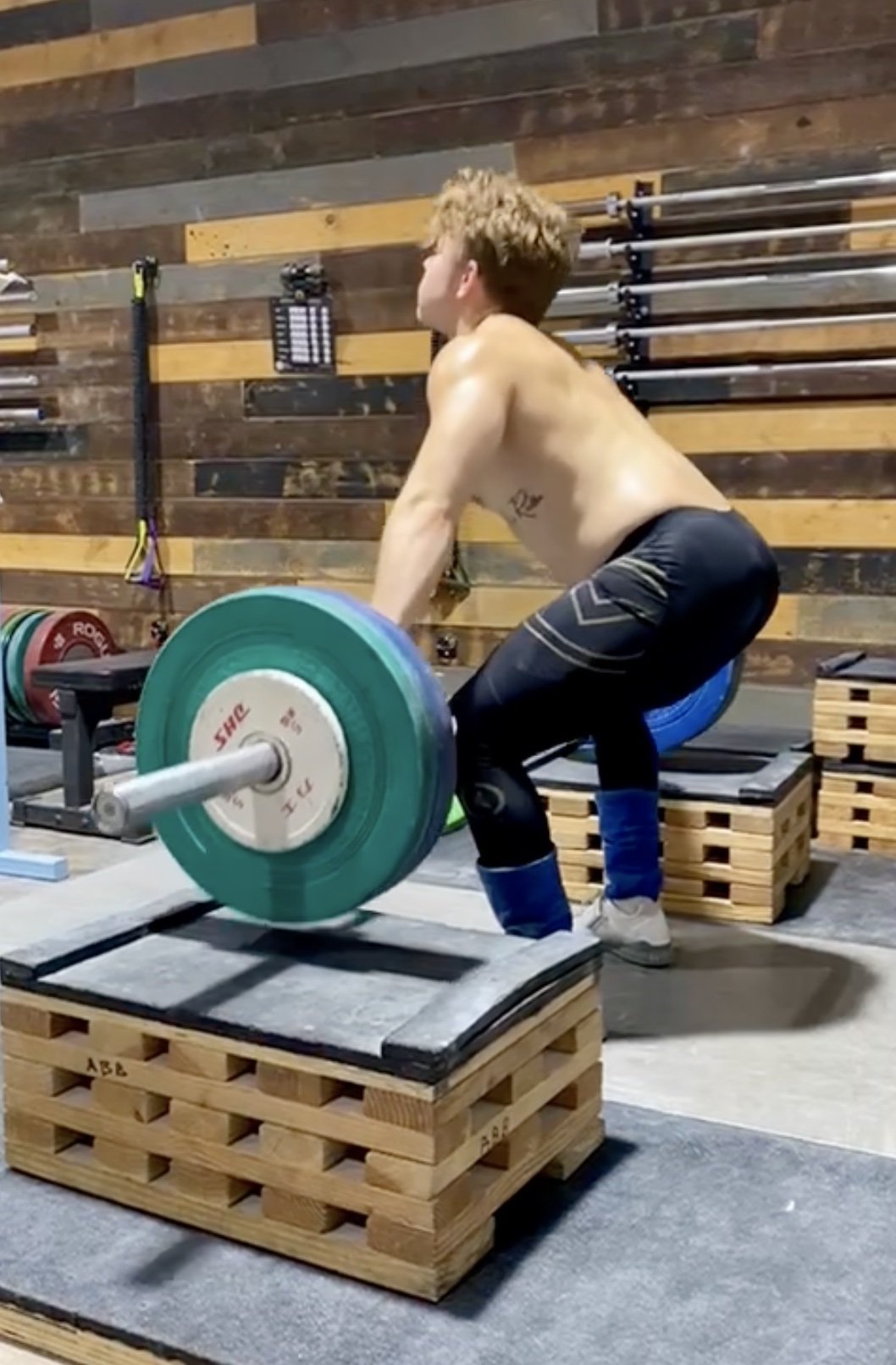Take Your Performance to the Next Level with Blocks
Why Train from Blocks? if Your Goal is to PR from the floor?
By Coach Rob Ronan, Austin Barbell
My coaching methodology is grounded in biomechanical principles, motor learning theory, and practical experience on the platform. We utilize individualized, data-informed programming to enhance neuromuscular coordination, develop force production, and improve technical consistency. Training is structured to balance progressive overload with recovery and long-term athlete development. Our environment supports both emerging and elite lifters through structured skill acquisition and strategic adaptation.
Training from blocks plays a critical role in this process. It allows for targeted refinement of specific phases of the snatch and clean, while managing overall fatigue by reducing unnecessary volume from full-range pulls. By altering the start position, coaches can emphasize positional awareness, reinforce proper bar path, and improve timing under the bar. This segmented approach facilitates more efficient learning and technical precision.
Block work also introduces essential variety into the training cycle, mitigating mental fatigue and supporting long-term progression. When implemented correctly, it serves as a key tool in developing the mechanics necessary for consistent performance on the competition platform.
What are weightlifting blocks?
Pulling blocks are a fundamental training tool for Olympic lifters across all levels. They allow coaches to isolate specific phases of the lift, reduce cumulative fatigue, and reinforce mechanical precision without sacrificing training intensity. By shortening the range of motion, blocks create an opportunity to focus on posture, bar path, and force application in a more controlled environment.
There are several styles of blocks—flat, contoured, adjustable in height—each serving a different purpose depending on the lifter’s technical needs. For example, contoured blocks, commonly used in Chinese weightlifting systems, restrict lateral bar movement and force a more vertical pull. These are especially effective for lifters who tend to shift their weight backward or lose tension during the transition phase of the pull.
When programmed correctly within the training cycle, block work becomes a precise tool for addressing technical inefficiencies and reinforcing optimal motor patterns.
Chinese Contour Blocks
Traditional Pulling Block
Step (Stair) Block
Benefits of Olympic Weightlifting Blocks
Training from blocks isn’t about novelty or appearance—it’s a practical method to develop specific components of the Olympic lifts with greater precision and less cumulative fatigue. When programmed with intent, block work can become a strategic tool for improving bar path, positional consistency, and RFD (rate of force development)
Weightlifting blocks elevate the barbell to varying heights—mid-shin, below the knee, above the knee—allowing coaches to target particular segments of the pull. This adjusted start position shortens the range of motion and alters the lift's mechanics, providing a focused environment to reinforce posture, timing, and balance.
Many athletes struggle to maintain proper positions through the transition phase of the pull. Block work offers repeated exposure to that segment, helping athletes internalize correct mechanics without the systemic fatigue of full-length pulls. When applied effectively, block training accelerates technical development and supports long-term performance outcomes.
Breaking Down the Pull
The pull is the foundation of both the snatch and the clean. When the pull is technically sound, the remainder of the lift becomes significantly more efficient and predictable. At Austin Barbell, we teach the pull in three distinct phases:
First Pull – From the floor to just below the knee. This phase emphasizes posture, rigidity, and maintaining bar proximity. It sets the tone for the rest of the lift.
Transition (Second Pull) – From below the knee to the power position. This is where the lifter re-bends the knees and shifts into the position of maximal force production. Proper timing and balance here are critical.
Third Pull – After full extension, the lifter moves under the barbell. This phase demands speed, precision, and positional confidence.
Training from blocks allows athletes to isolate and reinforce any one of these phases. It creates a controlled environment for developing technical consistency without the added fatigue of pulling from the floor every time.
Key Benefits of Block Work
Positional Reinforcement – Pulling from elevated positions forces the lifter to maintain vertical bar path and correct balance. It’s especially effective for athletes who tend to shift their weight backward or break posture through the pull.
Fatigue Management – With less range of motion, athletes can train intensively while minimizing systemic stress. This helps preserve quality across working sets and throughout the training week.
Targeted Development – Blocks are ideal for emphasizing specific weaknesses, such as timing at the knee or speed under the bar. They also allow for overload in particular segments of the lift.
Variation and Focus – While Olympic lifting is inherently repetitive, block work introduces structured variation, helping athletes stay mentally engaged and physically fresh.
Strategic Implementation
Block work should be programmed with clear intent. At Austin Barbell, we typically incorporate it at the following times:
Post-Competition or Early Preparation Phase – To rebuild movement patterns and reinforce technical foundations.
Mid-Cycle for Overload or Weakness Correction – To increase intensity or address limiting factors in the pull.
During Deloads or Tapers – To maintain sharpness while reducing volume and overall fatigue.
Block work is not random. It’s deliberate, purposeful, and designed to reinforce movement quality while supporting overall training goals.
Coaching Cues for Block Work
Here’s what I’m looking for when an athlete pulls from blocks:
Bar starts close—minimal gap between shin and barbell.
Ankles, knees, and hips stacked for vertical force production.
Shoulders stay over the bar longer than feels natural—especially below the knee.
Aggressive, vertical finish.
Don’t “rest” on the blocks. Tension starts before the bar leaves the wood.
Common Mistakes to Avoid
Treating it like a shortcut. This isn’t a cheat code—it’s a refinement tool. You still need to attack each rep with purpose.
Letting form slip. Just because it’s not from the floor doesn’t mean you can be lazy.
Using the wrong height. If you’re working on the second pull and your blocks are set to mid-shin, you’re in the wrong zip code.
Final Thoughts
While personal records are set from the floor, the foundation for those lifts is often built through focused, segmented training. Block work provides a structured approach to refining technical elements of the pull, allowing for greater consistency and efficiency when it matters most.
Olympic weightlifting demands precision under fatigue and repeatability under pressure. Training from blocks supports this by isolating critical positions, reinforcing proper movement patterns, and improving an athlete’s ability to execute reliably on the platform.
When programmed and executed with intent, block work translates directly to improved performance from the floor—not by replacing full lifts, but by enhancing their quality.
Conclusion
Finally, Olympic weightlifting blocks are an incredibly effective tool for Olympic weightlifters - from beginner to advanced competitors. They help reduce fatigue by forcing an athlete into ideal positioning intra-lift. Olympic weightlifting blocks can be used to perfect the technical control of the barbell and provide variation in Olympic weightlifting training. Olympic weightlifting blocks are a must-have tool for Olympic weightlifters who want to take their performance to the next level.
Don't forget your Olympic lifting straps for extra support and stability on those big lifts like the Snatch or clean pulls from the blocks. Good luck!






